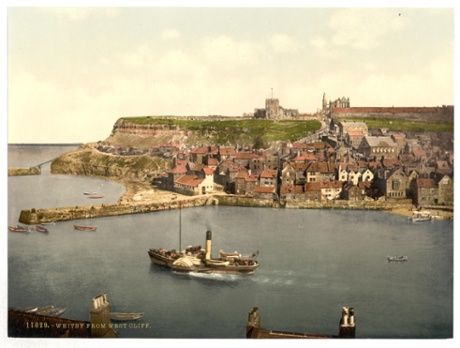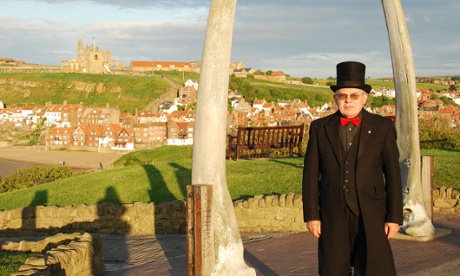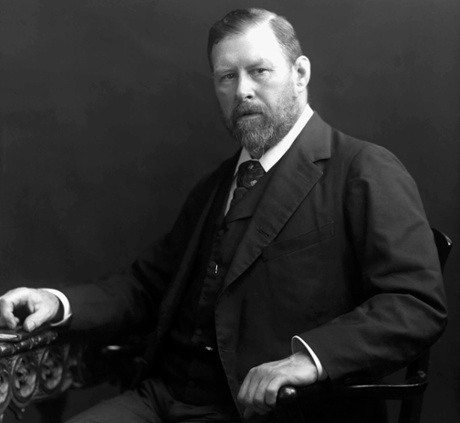
Dracula’s Abbey – Buy This Whitby Abbey photograph here.
If you stand on the pavement outside the Royal Hotel on Whitby’s West Cliff and look out across the harbour town as the sun goes down, you can pretty much see, in their entirety, the early chapters of Bram Stoker’s Dracula. Across the bay, in the shadow of the half-ruined abbey, sits St Mary’s Churchyard, where Lucy Westenra was attacked by the vampiric count. Below is Tate Hill Sands, where the ship carrying Dracula ran aground, its crew missing, its dead skipper lashed to the wheel. The 199 steps, known locally as the Church Stairs, rise to the East Cliff, up which Dracula, in the guise of a black hound, ran after arriving in Whitby.
It is the same view that Stoker himself would have seen, aside from one or two modern flourishes, exactly 125 years ago – a view that would become synonymous with his novel Dracula. It was at the end of July 1890 that the flame of Stoker’s classic was kindled. Stoker, then the business manager of the actor Sir Henry Irving, had just endured, with his theatrical company, a somewhat disastrous tour of Scotland. Irving decided they should all take a month’s holiday and then regroup; he suggested Stoker try Whitby on the north Yorkshire coast, where Irving had once run a circus.
Stoker took rooms at 6 Royal Crescent; his wife Florence and son Noel would join him in August, but it was in that week and a half alone, roaming the fishing port and talking to the locals, that the ideas that would become Dracula took hold. Little has changed in the streets around Royal Crescent since; a whalebone arch still stands, framing the cold grey North Sea (though the current one is the third to have been erected since the original in 1853). You could almost believe, on nights when sea frets dog the craggy coast, that a black-clad figure haunts the narrow alleys. In fact, here’s one now …

It’s Harry Collett, who dons Victorian dress and top hat to conduct Dracula-themed night-time walks around Whitby. He is a natural storyteller, fond of melodrama. “I’ve been doing the walks since about 92,” he announces. “… 1892!” He goes on: “Whitby was undoubtedly instrumental to Stoker when he wrote Dracula. When he took up residency in Royal Crescent, his landlady would turf him out in the morning so she could clean the room. Stoker would go to the reading room of the Royal Hotel and look out at the scene you can see now. That first week when he was alone in Whitby, he would go around, soaking up the ambience.”
Talking to the old salts on the harbour and mooching around the churchyard up on the East Cliff, Stoker assembled a catalogue of local myths and stories that are recognisable to anyone familiar with the Dracula story. In the novel, the count comes ashore when a Russian schooner, the Demeter, runs aground, all hands lost. This was based on a real event in 1885: a ship – the Dmitry – was beached on Tate Hill Sands.
“In the book,” says Collett, “Dracula runs ashore as a black dog. This is based on another legend Stoker would have heard about a dark hound – a story brought over by the vikings. And the black coach that later takes Jonathan Harker to Castle Dracula was taken from a local story about the lord of Mulgrave Castle, who used to take to a black coach that rattled down the road when he was on his way to court Elizabeth Cholmeley.”

It was 1897 when history was made with the publication of Dracula as a novel, though the story hatched in Whitby first came to life as a play, entitled The Undead. After the first test performance, his friend Irving reportedly told Stoker that he never wanted to see the play again, prompting its re-imagining as the epistolary novel. While working on the manuscript, Stoker researched the folklore of the Carpathian mountains and added to the experiences of Whitby by visiting St Michan’s Church and its eerie crypts in his native Dublin, which hold a number of mummified corpses dating back centuries.
Even as undeath preoccupied Stoker, life continued, and he began to work on a freelance basis for the Daily Telegraph in London, which would lead to a permanent position from 1905. He had cut his journalistic teeth on his hometown paper, the Dublin Evening Mail, which was co-owned by the writer Joseph Sheridan Le Fanu, a gothic writer whose novel Carmilla was one of the earliest vampire novels and almost certainly provided some inspiration for Dracula.
Stoker entered the literary and arty hub of fin de siècle London, counting as his friends not only a host of theatrical names, thanks to moving in Irving’s circles, but also the artist Whistler, fellow novelist Arthur Conan Doyle, and even Oscar Wilde, who was something of a love rival to the Dracula writer. Stoker’s wife Florence was not only a society beauty, but she had apparently thrown over Wilde to accept a proposal from Stoker. The two men had known each other at Dublin’s Trinity College and the love spat prompted a celebrated fallout between Wilde and Stoker, though they resumed their friendship after Wilde’s trials and exile to Paris.

Stoker died in April 1912, possibly from syphilis. Before his death, the writer suffered a series of strokes and, according to his nephew Daniel Farson, the death certificate gave as one cause “Locomotor Ataxy 6 Months” – apparently a euphemism for the sexually transmitted disease. But the mark Stoker left on the town is as indelible as a pair of pinprick bites on a snow-white neck. In the fudge shop on the front, you can buy chocolate coffins, and there is of course the Dracula Experience, where for a few pounds you can creep through labyrinthine pitch-black passages and be scared out of your skin by students earning holiday cash dressed up as ghouls and revenants.
Meanwhile, there’s the Bram Stoker international film festival, and the Whitby Goth weekend, a twice-yearly fixture in spring and around Halloween. And, to coincide with the 125th anniversary of Stoker’s creation, family-friendly promenade stagings of Dracula are being held throughout August in the environs of Whitby Abbey.
Of course, some who visit Whitby on the Dracula trail have trouble accepting that Stoker’s novel is actually a work of fiction. A former rector of St Mary’s Church used to mischievously direct tourists asking for the location of Count Dracula’s grave to a cracked tomb in the churchyard, its inscription long-since weathered away by the unforgiving salt-laden winds. Harry Collett got so tired of being asked the same question that he had a stonemason make up a false headstone – and had it placed at a suitable location on his walk.
guardian.co.uk © Guardian News & Media Limited 2010
Published via the Guardian News Feed plugin for WordPress.


















